Artichoke scraps and leftovers are full of flesh, taste, and nutrients that can be easily extracted and reused to make simple, nutritious, and delicious zero-waste artichoke recipes.
In this blog post, we show you how to cook and use artichoke scraps to prepare 4 delicious vegan artichoke recipes.
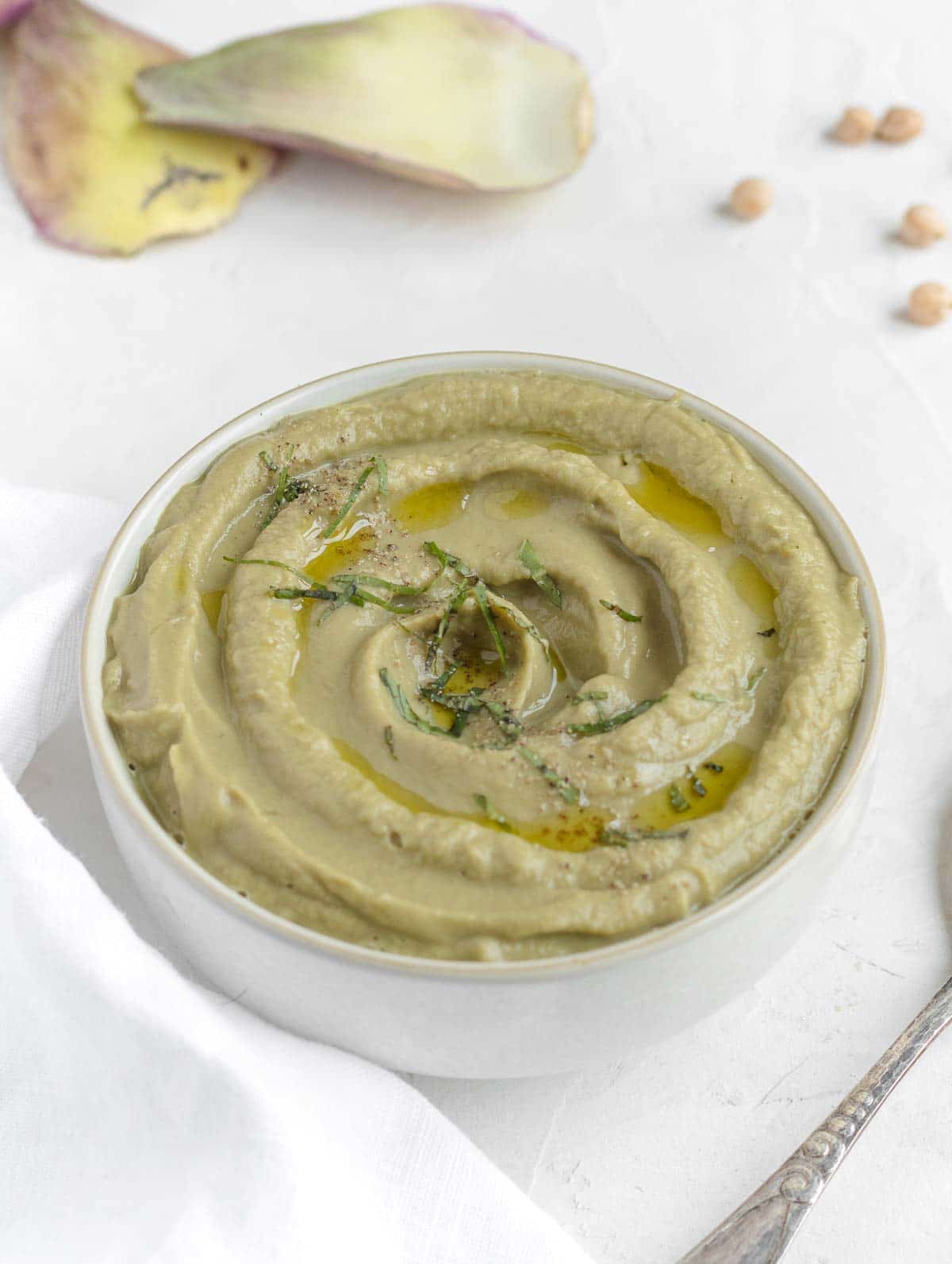
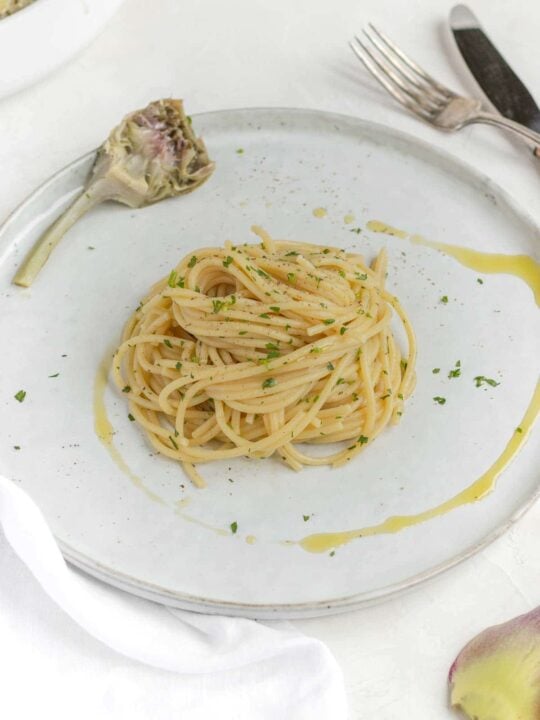
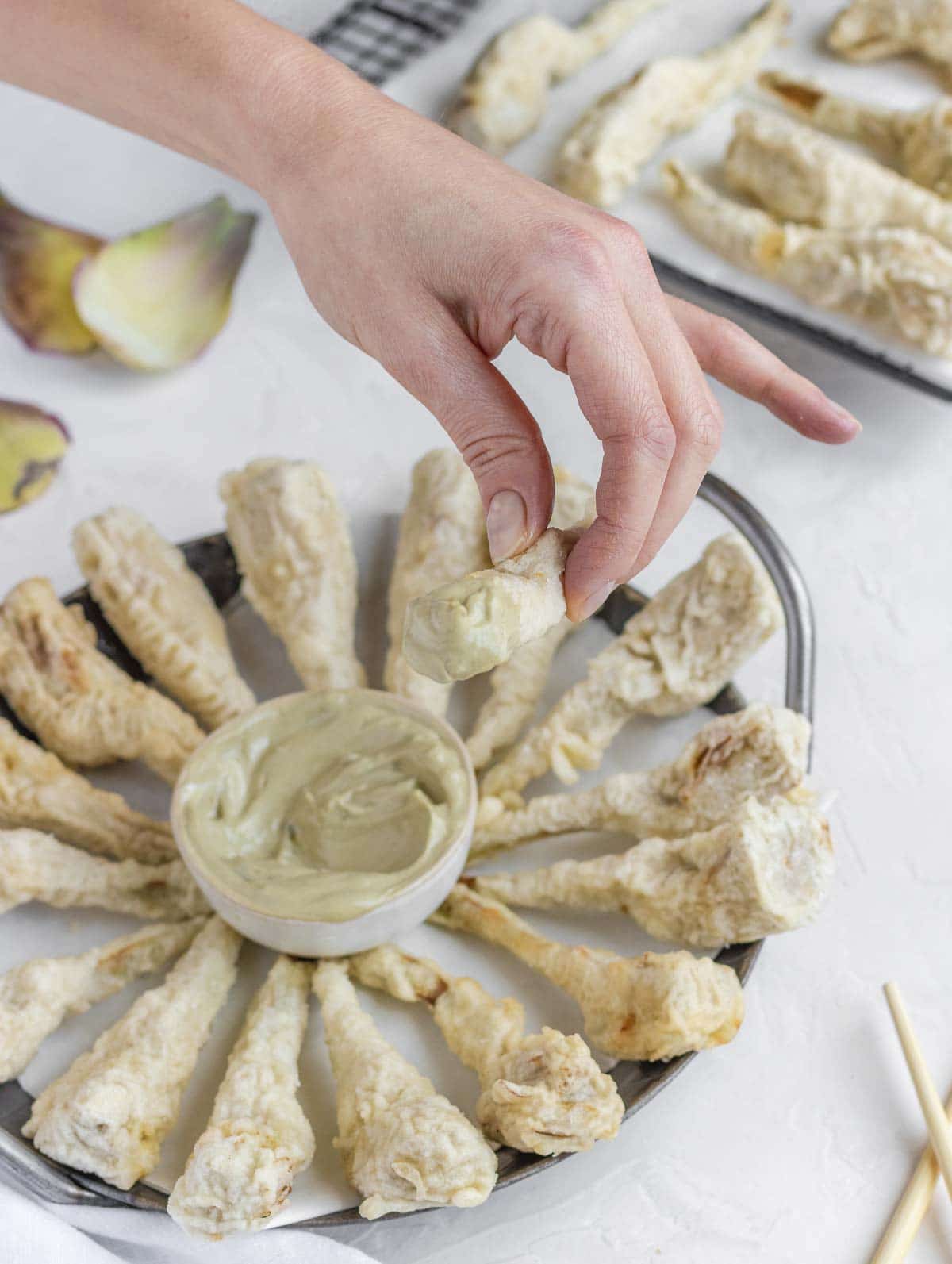
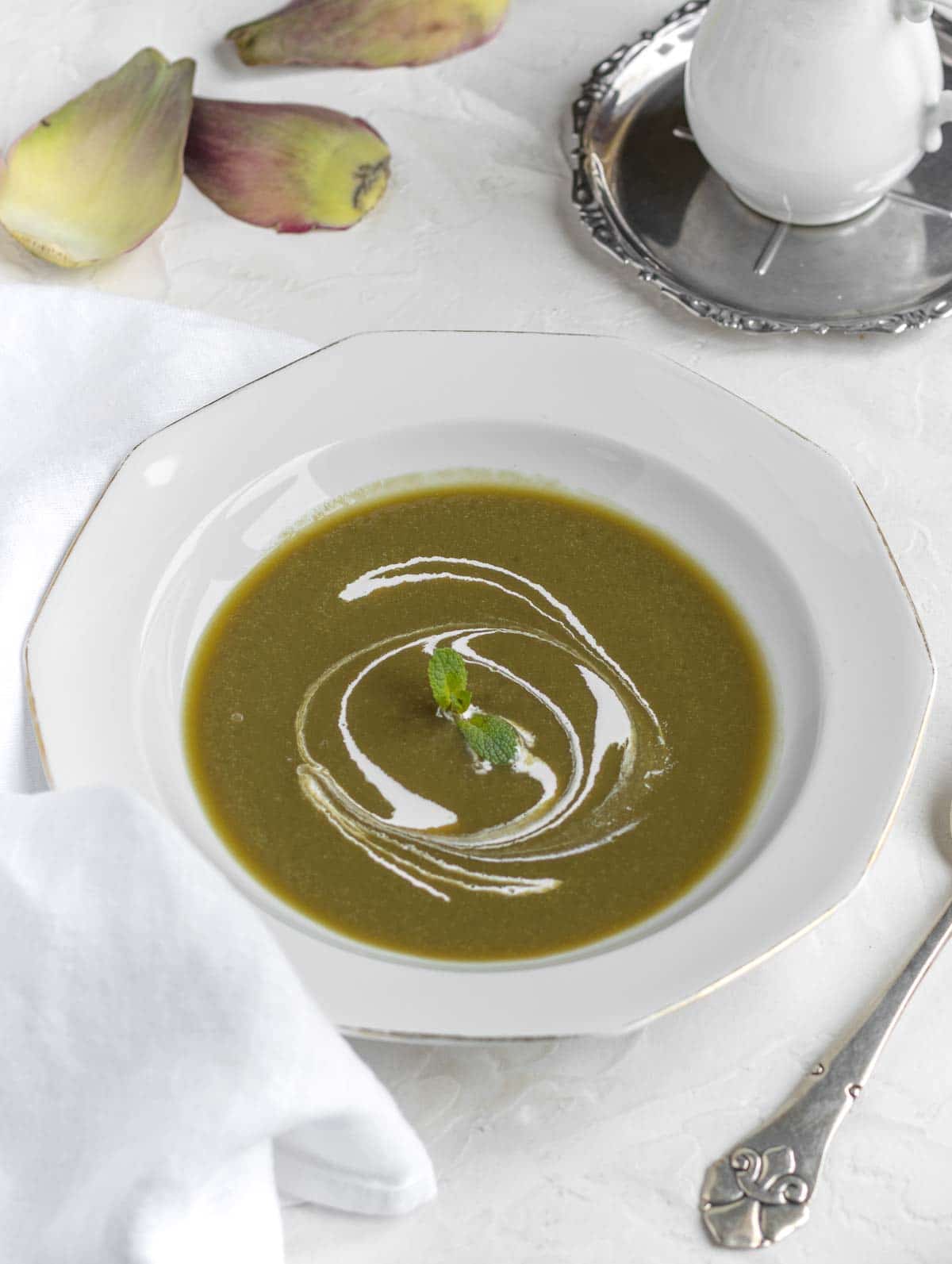
TIP: Are you curious about artichokes? Here’s our ultimate guide on how to cook with artichokes with 10+ easy artichoke recipes.
What are artichoke scraps?
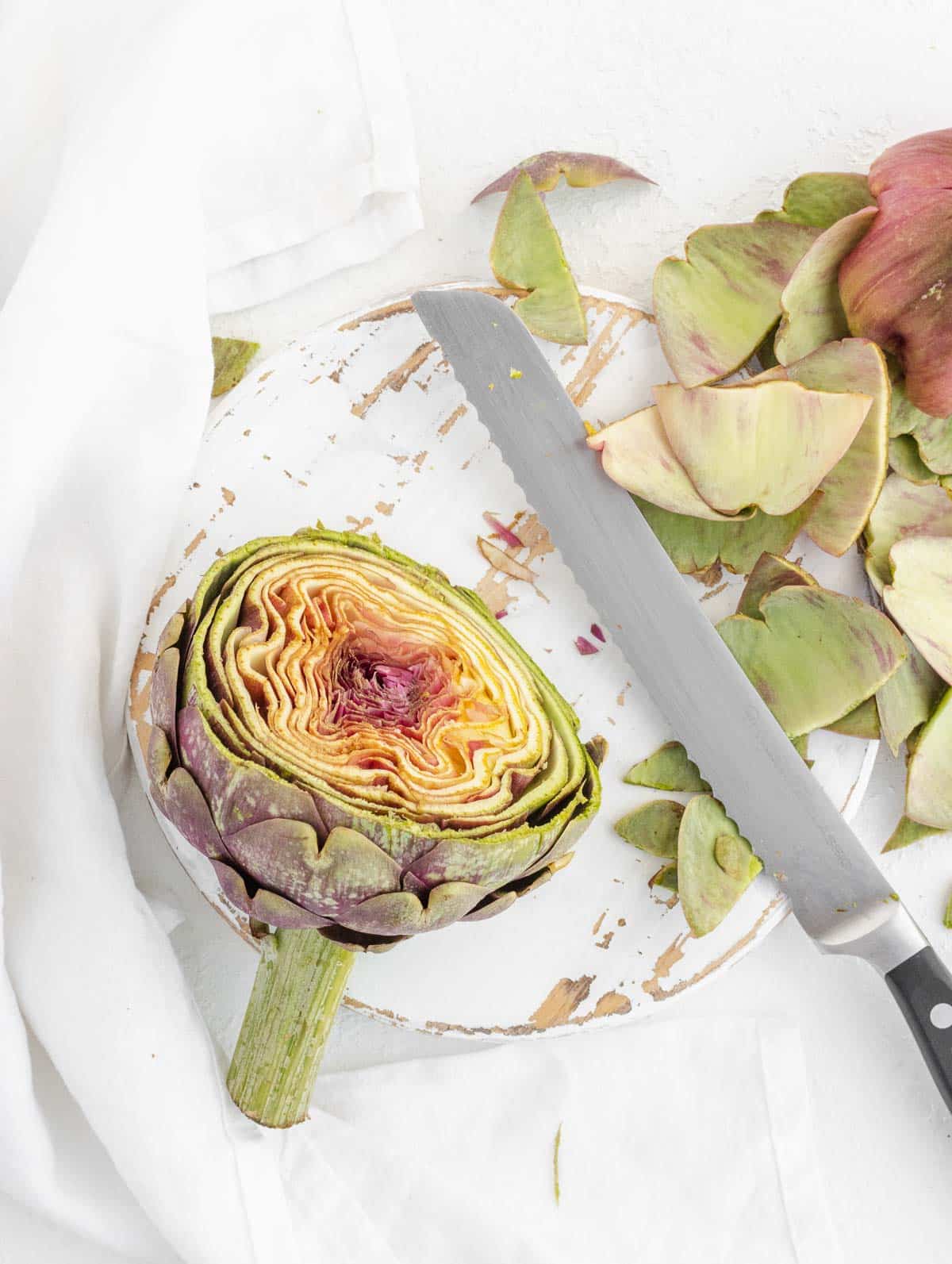
With artichoke scraps we mean the stalk, leaves, thorns, petals, and peel that you would normally throw away when you prepare artichokes.
To use them, we first wash the scraps, then we boil them for about 1 hour, and then we extract the flesh with a simple rotary vegetable mill. The result is a delicious artichoke concentrate that can be used in many ways.
In this blog post we use stalk, petals and cooking water of the artichokes to make 4 delicious zero-waste recipes: artichoke hummus, artichoke cream, artichoke mayonnaise and spaghetti with artichoke cooking water.
To learn more about artichokes, check out our guide “how to cook artichokes“, which includes 10 delicious and easy artichoke recipes.
Ingredients
For the artichoke hummus

We make artichoke hummus with the scraps – leftover leaves and stems – of the artichokes. We first boiled the scraps in water, then extract the pulp with a rotary vegetable mill.
Then in a blender we mix the artichoke pulp with chickpea, lemon, tahini, mint, olive oil, salt and pepper for a unique, creamy, nutritious and delicious artichoke spread.
- Artichoke scraps: to flavour the hummus we used the flesh extracted from boiled artichoke leaves and stems.
- Chickpea: we use canned chickpeas but other legumes work too.
- Extra virgin olive oil: in this hummus we use olive oil instead of Tahin. The flavour of the olive oil goes perfectly with artichoke. If you want you can replace olive oil with Tahin.
- Lemon juice: just a tablespoon to add some acidity, freshness and flavour to the hummus.
- Mint leaves: we add a few leaves of mint because mint is a perfect match to artichokes. You can replace mint with parsley.
- Tahini: made with hulled sesame seeds. It’s essential in hummus.
- Salt and pepper: add both to bring out the artichoke flavour.
For the artichoke cream

This artichoke cream is made with 100% pure artichoke pulp extracted from the boiled scraps (leaves and stems) of the artichokes with a rotary vegetable mill. We only add a pinch of salt to this concentrate of flavour and nutrients. This is one of the most delicious and pure vegetable creams I have ever tasted. And it’s made from artichoke waste!
- Artichoke scraps: we use the flesh extracted from boiled artichoke leaves and stems as the base for this cream. It’s so delicious you won’t need many other ingredients.
- Salt and pepper: add both to bring out the artichoke flavour.
- Soy cream: we add just a tablespoon of soy cream for two reasons. First for a beautiful white and green visual effect. Second, to add fat to the otherwise fat-free artichoke cream. You can replace soy cream with extra virgin olive oil.
For the artichoke mayonnaise
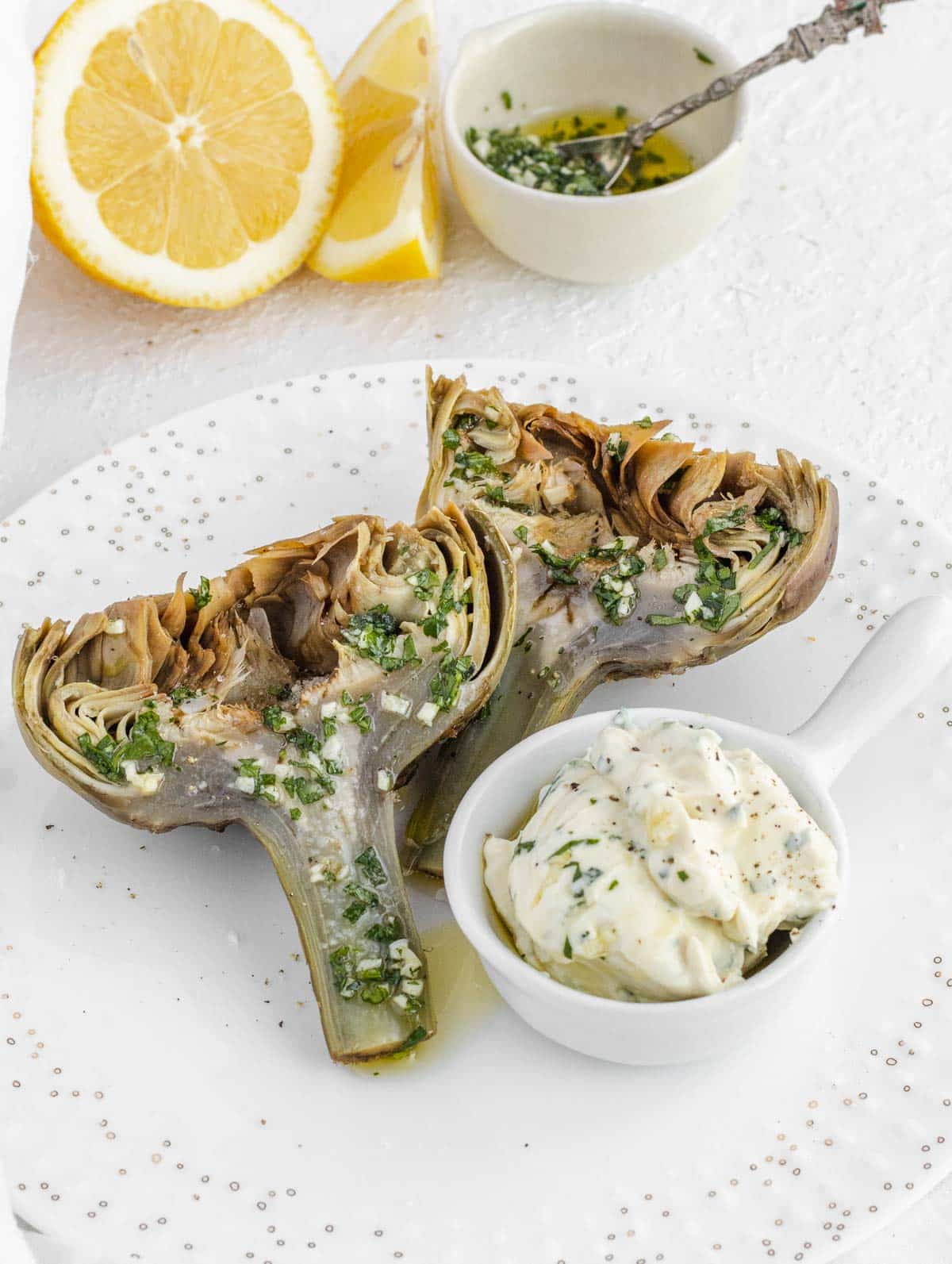
This is best served with steamed artichokes. We first make a standard vegan mayonnaise with 2 parts of vegetable oil (we like to mix 25% olive oil and 75% sunflower oil) and 1 part of soy milk. Add a dash of lemon juice, a pinch of salt then mix it with the artichoke pulp extracted from the scraps of the artichokes with a rotary vegetable mill. Delicious!
- Vegan mayonnaise: we make our own by blending together 1 part of soy milk and 2 parts of vegetable oil (75% sunflower seed oil and 25% olive oil). We then add a pinch of salt and lemon juice for a delicious vegan mayo.
- Artichoke scraps: to flavour the mayonnaise we used the flesh extracted from boiled artichoke leaves and stems.
Spaghetti aglio, olio and artichoke sauce
Another zero-waste vegan recipe, this time made with the leftover cooking water from our roman-style braised artichokes. This is so simple, yet so delicious. All you have to do is to take all the leftover cooking water of your braised artichokes, then cook some spaghetti al dente and mix it in the artichoke water. Add some olive oil, fresh parsley, and if you still have some, a few pieces of artichokes. Enjoy!
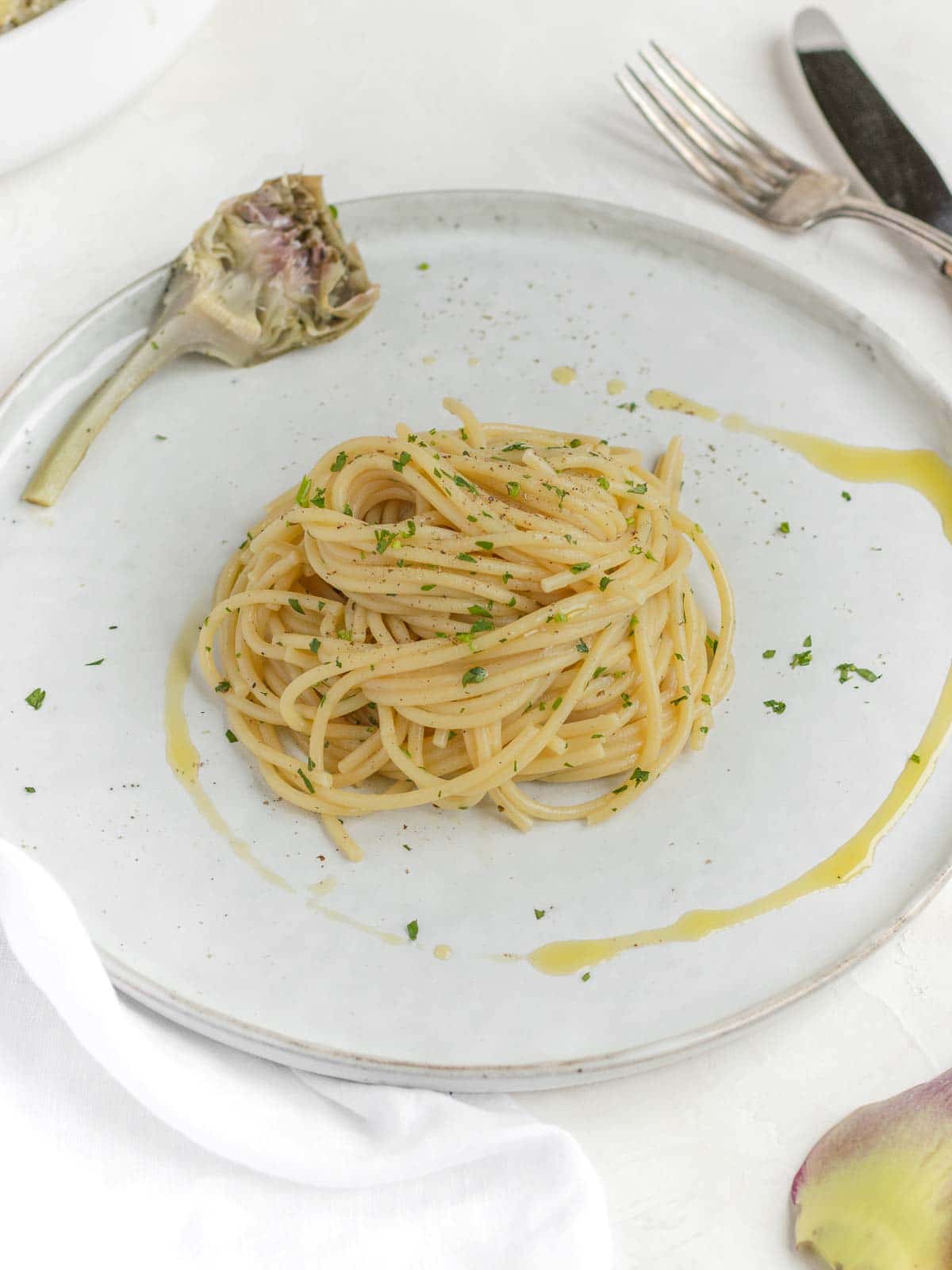
- Leftover artichoke sauce: as a sauce for this delicious spaghetti dish we use the leftover sauce from our braised artichoke recipe (carciofi alla romana).
- Spaghetti: bronze-cut Italian made spaghetti are best for this recipe. Naturally vegan and made with only hard-wheat flour and water.
- Coarse salt: to season the pasta cooking water.
- Parsley: we sprinkle it on the pasta to add freshness and colour.
- Olive oil: you might need to add a dash of olive oil to make this dish extra delicious.
Equipment
To make our artichoke hummus, cream and mayonnaise you need a rotary vegetable mill to extract the pulp from the scraps of the artichoke. You can easily find one on amazon and its a perfect tool to make really good tomato passata, mashed potatoes, and to turn any legume and vegetable into a delicious, thick and earthy cream.
Tips
- Boil the scraps long enough: artichoke scraps are though due to their high fibre content. Boil them for at least 1 hour.
- Use a rotary vegetable mill: an old style rotary vegetable mill with a medium disc is the best tool to extract the pulp out of the scraps. You can easily get one on Amazon.
- Blend the pulp: do NOT use a blender to extract the pulp from the scraps, use a vegetable mill instead. However, once you have extracted the pulp it is best to blend it at high speed to break apart the little pieces of fibre that are left in the pulp and make the whole thing smoother.
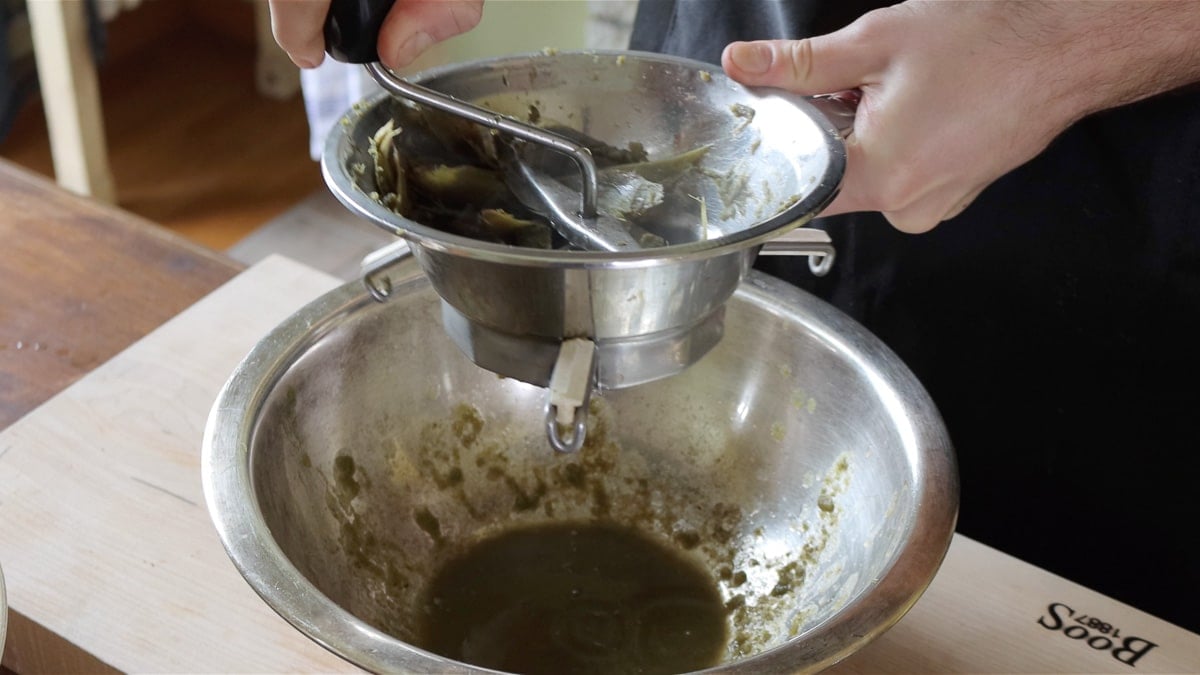
Storage
You can store the artichoke scraps before extracting the pulp for up to a full week after you take them off of the artichokes. Just keep them in a large pot in a cool corner of your kitchen.
Once you have extracted the pulp it’s best to prepare your recipes as soon as possible so that you’ll get maximum nutrients. If you want to store it, do so by putting the artichoke pulp in an airtight container and store in the refrigerator for up to a couple of days.
After you prepared the recipes, they can all be stored in the refrigerator for up to 2 days.
More artichoke recipes
- How to cook artichokes with our best artichoke recipes
- Steamed artichokes
- Roasted artichokes
- Pan fried artichokes
- Braise artichokes – Italian style artichokes
- Artichoke pasta
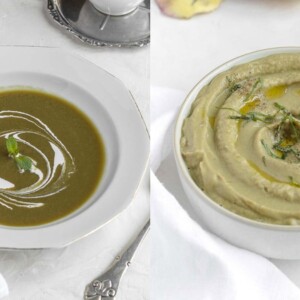
How to use artichoke scraps
Equipment
- Rotary vegetable mill
Ingredients
For the artichoke hummus
- 18 ounces artichoke scraps leaves, stalks, peel
- 1 tablespoon tahini
- 1 can chickpeas
- 2 tablespoons olive oil extra virgin
- 1 tablespoons lemon juice
- 1 teaspoon salt
- 5 leaves mint
For the artichoke cream
- 25 ounces artichoke scraps leaves, stalks, peel
- 1 teaspoon salt
- 1 pinch black pepper
- 4 tablespoons soy cream or olive oil, or cashew cream, or rice cream
For the artichoke mayonnaise
- ⅓ cup sunflower oil or canola oil
- 2 tablespoons olive oil
- 3 tablespoons soy milk unsweetened
- 1 tablespoon lemon juice
- ½ teaspoon salt
- 3 tablespoons artichoke pulp made from the scraps
For the spaghetti with artichoke sauce
- 11 ounces spaghetti bronze-cut
- 2 tablespoons olive oil
- 1 tablespoon parsley minced
- 1 cup leftover liquid from braised artichokes
Instructions
How to extract the pulp from artichoke scraps
- In a very large pot bring water to boil. Wash the artichoke scraps – leaves, stalk, peel, petals – then add them to the boiling water.
- Boil the artichoke scraps for at least 1 hour, stirring occasionally to make sure all scraps cook evenly.
- With a rotary vegetable mill start milling / grinding the boiled artichoke scraps. Place a bowl under your vegetable mill to collect the artichoke pulp coming out of the scraps. You should end up with thick green artichoke pulp.
- If you want your pulp extra smooth, then add it to a high speed blender and blend at full speed for 5 minutes.
For the artichoke hummus
- In a blender add all the ingredients (chickpea, tahini, artichoke pulp, olive oil, lemon juice, salt, pepper, and mint leaves) and blend at full speed for a few minutes until you get a smooth and creamy artichoke hummus.
For the artichoke cream
- Add the artichoke pulp to a high speed blender, add a pinch or two of salt and blend at full speed for 5 minutes. If your blender is powerful enough, your cream will warm up enough and there won't be a need for cooking the cream. If your blender is not fast enough, then take the cream out of the blender and warm it up in a pot for just a minute.
- Serve in a bowl with a drizzle of soy cream or extra virgin olive oil.
For the artichoke mayonnaise
- In a tall and narrow container (something like a tall mason jar with a wide opening) add the soy milk at room temperature, the lemon juice and a pinch of salt. Then with a hand blender, start blending into the soy milk and add the oil in a steady stream, very slowly. NOT all at once. Keep blending at all times.
- Keep adding the oil, very slowly, until you run out of oil. Blend while moving the blender up and down until you reach a thick, creamy, mayonnaise consistency.
- Now take some artichoke pulp extracted from the artichoke scraps and add it to the mayonnaise. Stir and enjoy. TIP: to get a stronger artichoke flavour, first dehydrate the artichoke pulp on a non stick pan on low heat to concentrate its flavour. Then let it cool down and add it to the mayonnaise.
For the spaghetti with artichoke sauce
- Cook the spaghetti al dente in salted boiling water, then on a pan add the leftover artichoke sauce from your braised Roman style artichokes (carciofi alla romana).
- Add the boiled spaghetti to the pan. Drizzle with olive oil and fresh parsley. Mix the sauce with the spaghetti adding some pasta water if necessary. Serve with a pinch of black pepper and enjoy!TIP: to make this dish even more delicious, add some pieces of leftover braised artichokes if you have them.
Notes
Nutrition
You might also like:
Collections
40 Best Vegetable Sides
Collections
65 Plant-Based Italian Recipes
Collections
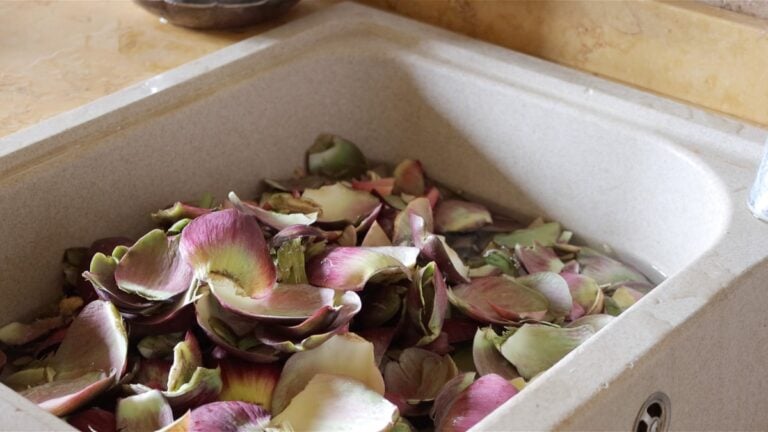
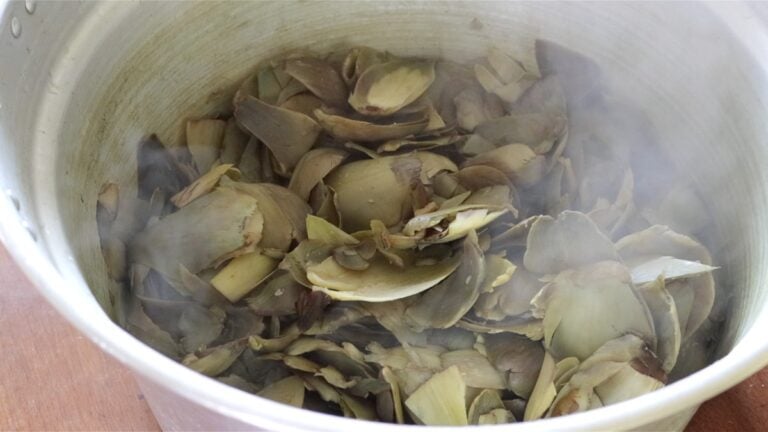
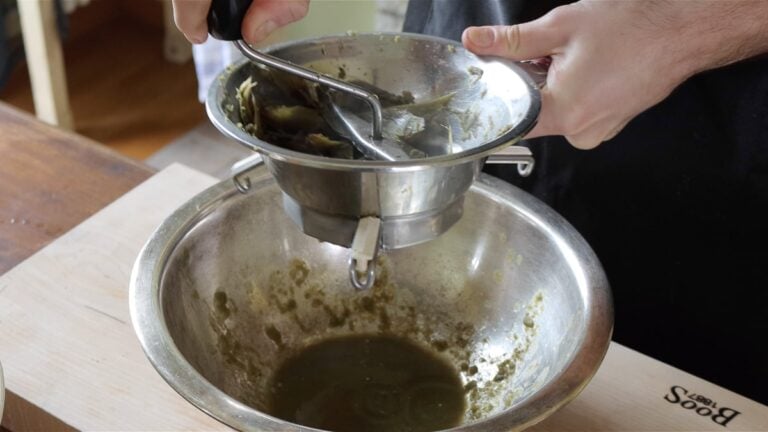
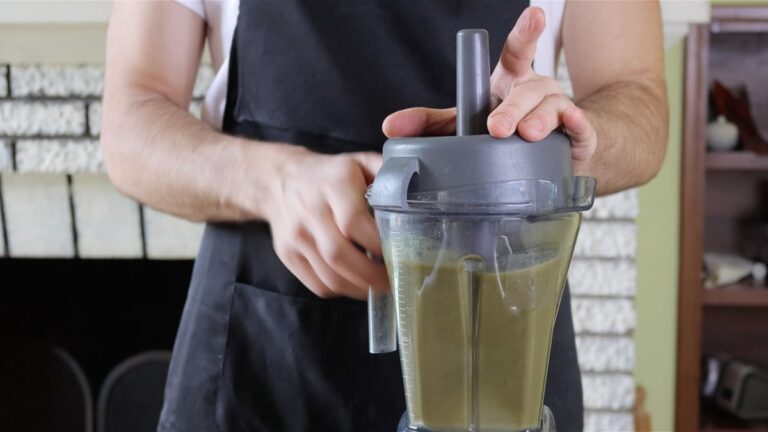
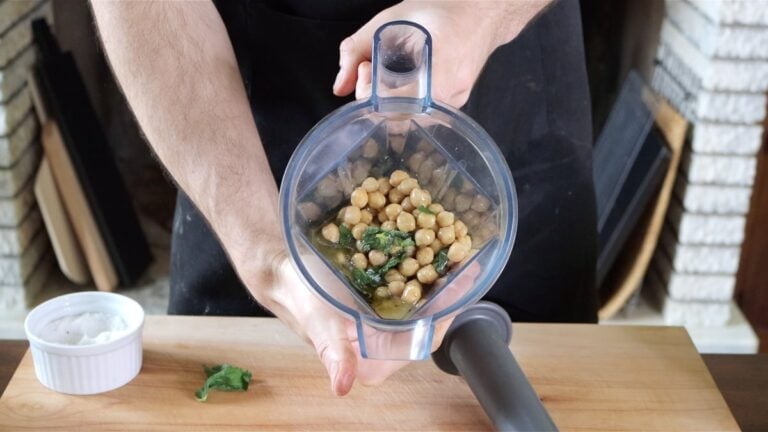

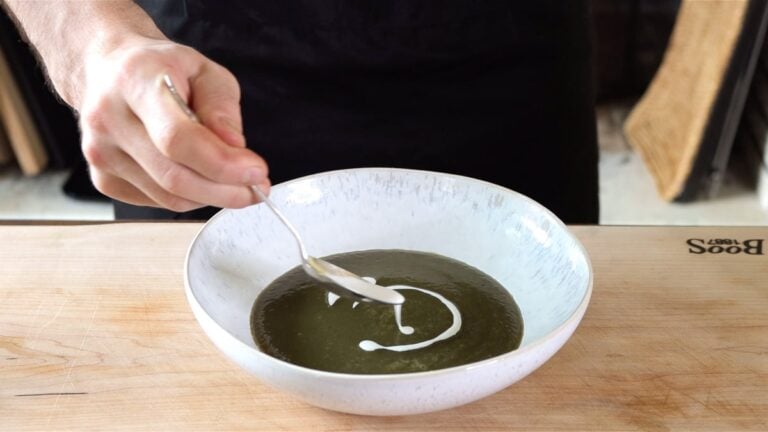
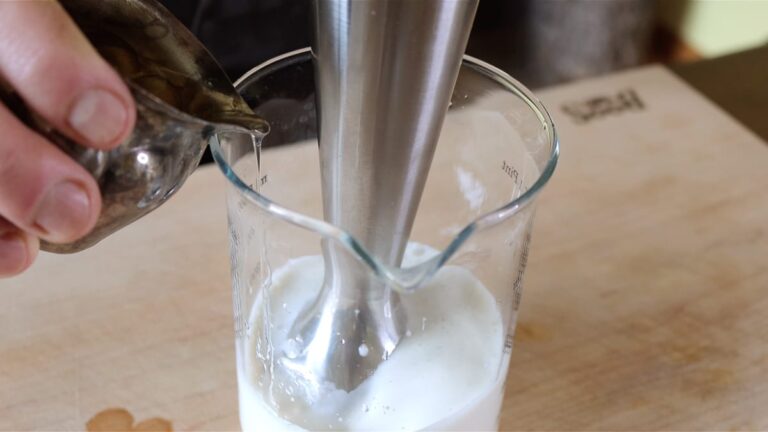
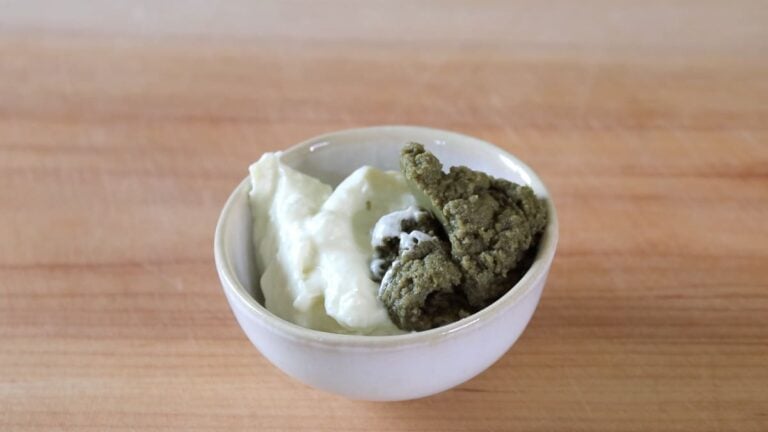
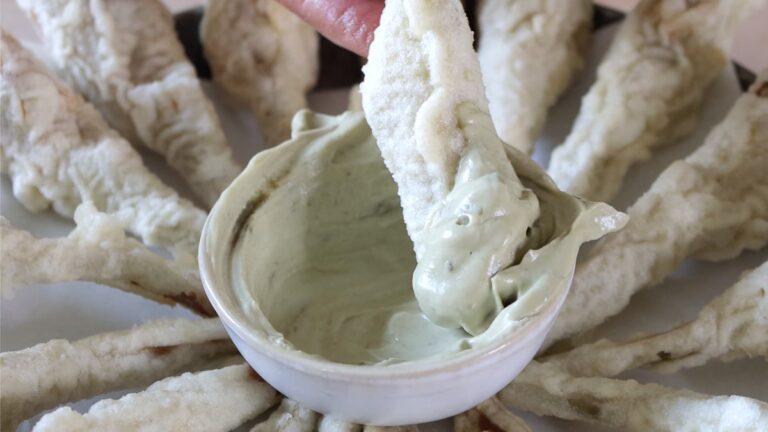
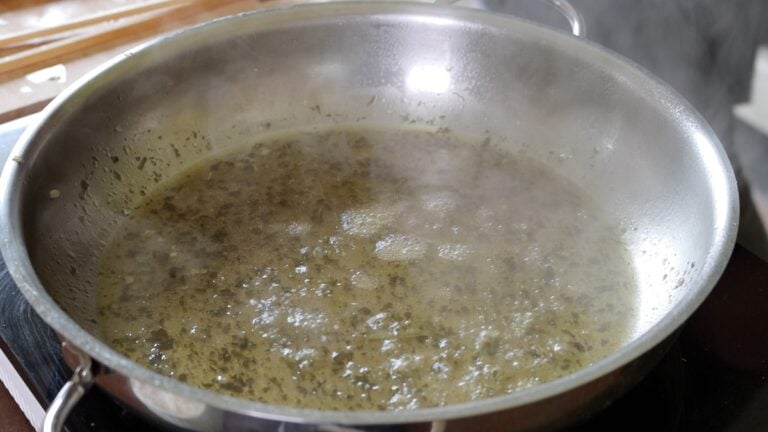
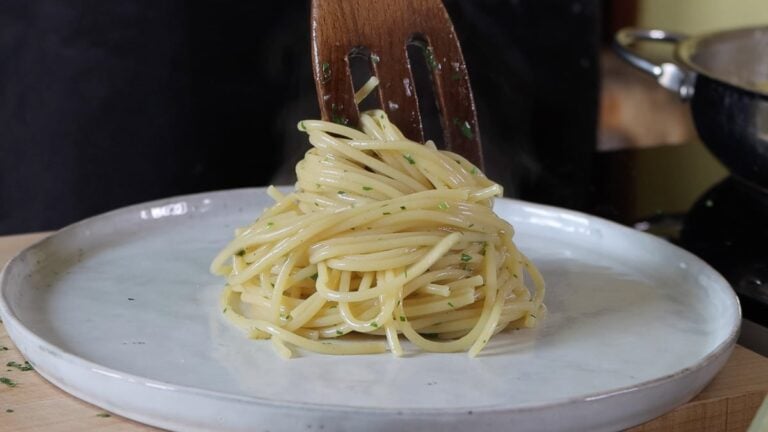
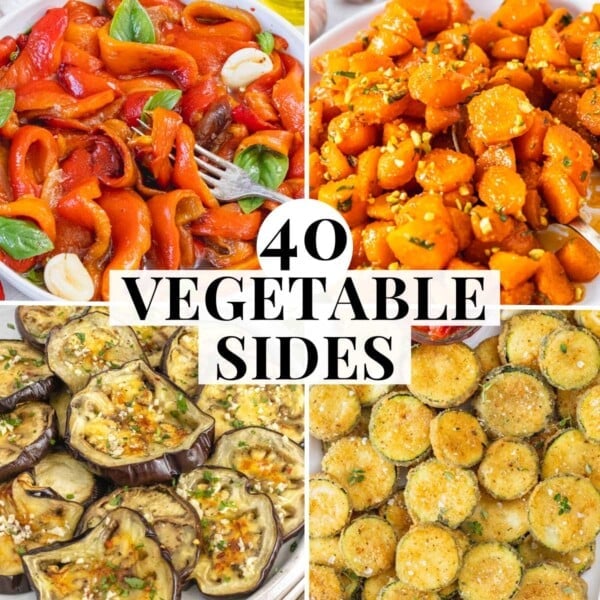



Excellent uses of the artichoke scraps! The food mill part is a bit tedious, but the resultant broth is excellent for use in many recipes!
Hi Pete,
Thanks so much! We figured it would be a pity to through out so much flavor-potential 😉
Have a great weekend! Kindest,
Louise
Love these recipes!
Have you tried putting the scraps in an instant pot, rather than boiling on a stove? Saves on GHG emissions if you have a natural gas stove!
Hi Jeannie, thanks for taking the time to comment! I haven’t tried instant pot but it’s on our wish list/get-it-soon list, thanks for the tip. Cheers, Nico
These recipes look fantastic!
Have you ever used — and do you have recipes for — the large leaves from the artichoke plant (vs. the little leaves off the artichoke itself)? I have some giant artichokes with giant leaves and would like to find recipes using them.
Hi Pamela, Thanks for leaving a comment! I did in fact use the large leaves that were leftover scraps from artichokes to make the artichoke soup, pasta and hummus in this post. If you mill or grind those leaves they are perfect for soups, pasta sauces and mayos. I hope that helps! Cheers, Nico